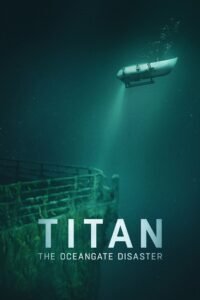
Video Sources 4 Views Report Error

Watch Online And Download Titan: The OceanGate Submersible Disaster Latest Movies 2025 | MoviezVila
The deeper you look, the darker it gets.Jun. 06, 2025n/A112 Min.n/A
Synopsis
OceanGate’s Titan tourist submersible imploded in 2023 on a deep-sea dive to the Titanic. This documentary details how a bold vision ended in tragedy.
In June 2023, a deep-sea expedition meant to offer a glimpse into one of the most famous shipwrecks in history ended in catastrophe. The Titan submersible, operated by OceanGate Expeditions, vanished in the North Atlantic Ocean during a dive to the wreckage of the RMS Titanic. What followed was a tense, international search and rescue operation that captured global attention—and ended in heartbreak.
This tragedy not only raised questions about deep-sea exploration and safety regulations but also served as a sobering reminder of the risks involved when pushing the boundaries of human exploration.
The Mission
OceanGate Expeditions had marketed its Titan submersible dives as a once-in-a-lifetime opportunity to visit the Titanic, located nearly 12,500 feet (about 3,800 meters) below the surface of the Atlantic. Priced at $250,000 per person, the voyage targeted wealthy adventurers, researchers, and those with a fascination for maritime history.
The Titan submersible, made of carbon fiber and titanium, was designed to carry five people on each dive. The June 2023 expedition was part of OceanGate’s ongoing missions to document the Titanic’s decay and gather data on deep-sea ecosystems.
The Disappearance
On June 18, 2023, the Titan began its descent toward the Titanic wreck site. Approximately 1 hour and 45 minutes into the dive, contact with the submersible was lost. A full-scale rescue operation involving the U.S. Coast Guard, Canadian authorities, and deep-sea experts from around the world was launched.
As hours turned into days, sonar buoys, aircraft, and remotely operated vehicles (ROVs) scoured the ocean in hopes of locating the missing submersible. The world anxiously watched, clinging to hope that the five individuals onboard were still alive.
The Tragic Outcome
On June 22, 2023, debris from the Titan was discovered near the Titanic wreck site. Analysis confirmed that the submersible had suffered a catastrophic implosion, killing all five occupants instantly. The pressure at that depth—over 5,500 psi (pounds per square inch)—meant survival after structural failure was impossible.
The victims included:
- Stockton Rush, CEO of OceanGate and pilot of the Titan
- Hamish Harding, British billionaire and explorer
- Shahzada Dawood and his son Suleman Dawood, a prominent Pakistani-British business family
- Paul-Henri Nargeolet, a renowned French Titanic expert
Each had their own motivations for joining the expedition—curiosity, science, legacy—but all shared a tragic fate at the bottom of the ocean.
Public and Industry Response
The Titan disaster sparked widespread media coverage, public mourning, and criticism. Many questioned the safety protocols followed by OceanGate, particularly given that the submersible operated outside of regulatory oversight. Unlike ships and aircraft, deep-diving submersibles in international waters often fall into a legal gray area, which can allow commercial expeditions to proceed without rigorous safety inspections.
Stockton Rush, in past interviews, had downplayed regulatory concerns, stating that “regulation stifles innovation”—a quote that took on a chilling tone after the tragedy.
Industry experts voiced concerns about the Titan’s experimental design, especially the use of carbon fiber, which is known to be susceptible to fatigue under extreme pressure. Several former employees and consultants had reportedly raised red flags prior to the incident, which were allegedly ignored.
A Symbol of Ambition and Hubris
The Titan disaster, like the Titanic itself, has become a symbol of both human ambition and hubris. The tragedy echoed eerie parallels to the original 1912 sinking of the Titanic: a voyage of confidence in technology, inhabited by the elite, ended in the crushing reality of nature’s power.
It also reignited discussions about risk in exploration—when is the pursuit of discovery worth the danger? Can adventure and science coexist with responsible safety standards?
Lessons for the Future
In the wake of the Titan implosion, there has been a push for:
- Stricter international safety regulations for deep-sea vessels
- Greater transparency from private companies offering extreme tourism experiences
- Increased oversight for experimental technologies in high-risk environments
OceanGate suspended all future operations, and investigations by U.S. and Canadian authorities were launched to understand the technical causes and accountability behind the disaster.
Cultural Impact
Beyond the headlines, the Titan tragedy has entered the global consciousness as a sobering story of modern exploration. Documentaries, news specials, and books are already being developed to tell the story—some honoring the bravery of the individuals involved, others critiquing the systems that failed them.
It also sparked a global dialogue on elitism in exploration, as the incident contrasted starkly with other global humanitarian crises happening at the same time—raising ethical questions about media attention, wealth, and risk.
Final Thoughts
Titan: The OceanGate Submersible Disaster is more than just a tale of technology gone wrong. It is a story about the human desire to explore, to push boundaries, and to see what lies beneath the surface—sometimes at great cost.
As the world looks to the stars and to the ocean’s darkest depths, the Titan disaster will serve as a painful reminder: progress must be pursued with caution, and ambition must be balanced with responsibility.
Original title Titan: The OceanGate Submersible Disaster
IMDb Rating n/A n/A votes
TMDb Rating 7.108 65 votes
Director
Director
Cast
Self (archive footage)
Self (archive footage)
Self
Self
Self
Self
Self
Self










